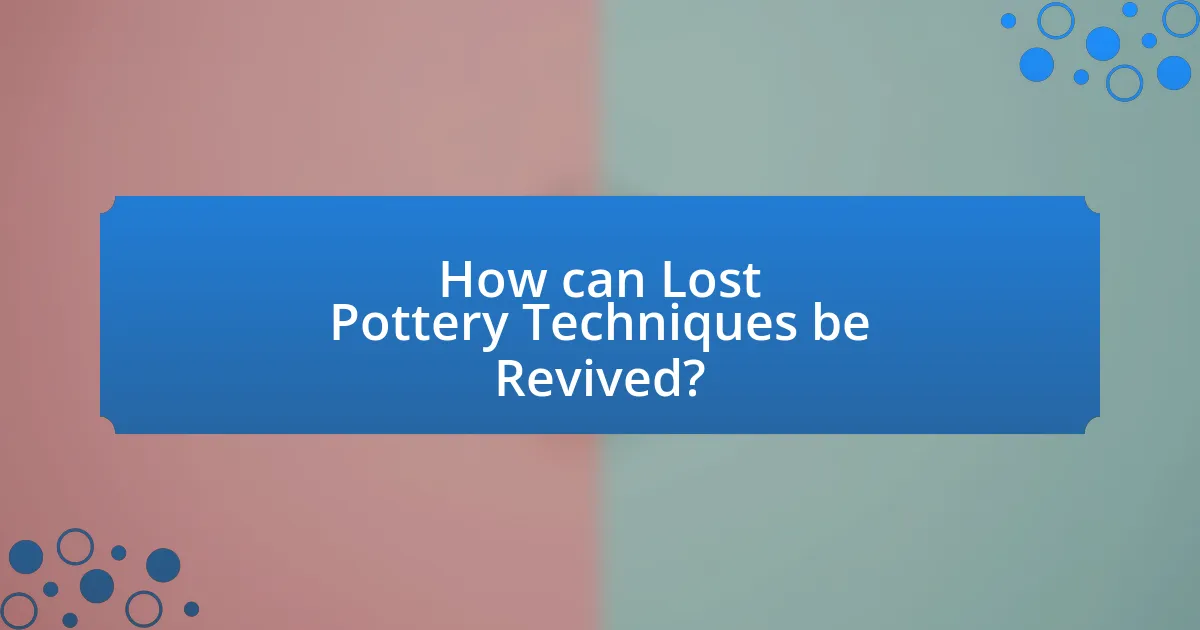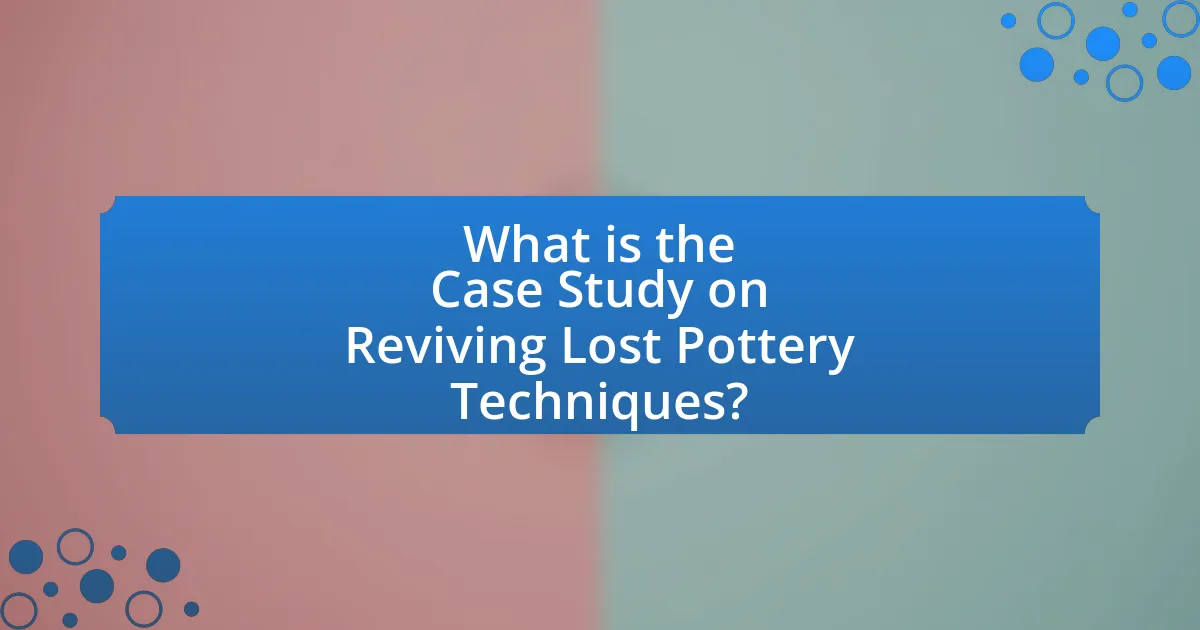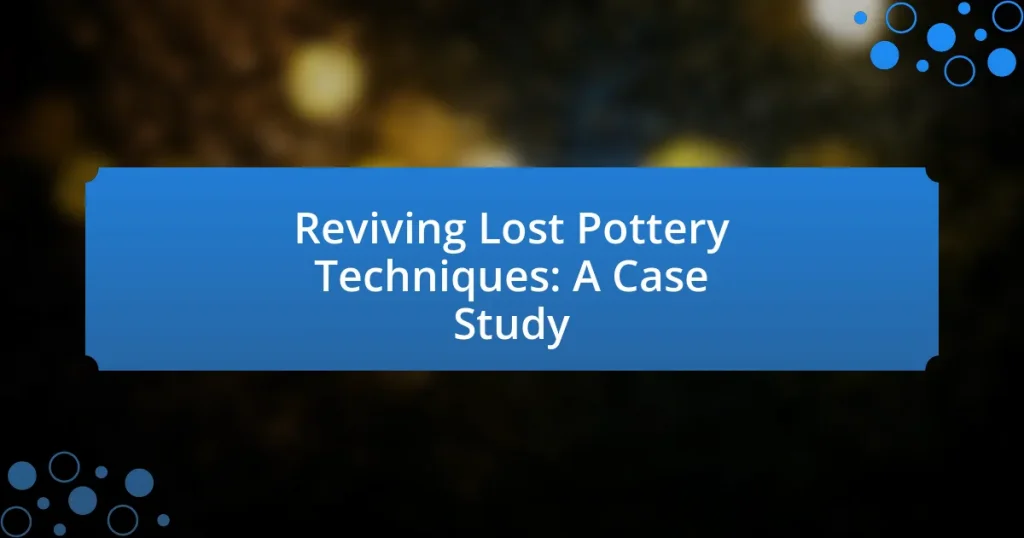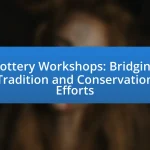The article focuses on the revival of lost pottery techniques, which are traditional methods of pottery-making that have been forgotten due to historical, cultural, and technological changes. It explores the reasons behind the decline of these techniques, including industrialization and globalization, and highlights the significance of preserving cultural heritage through artisanal skills. The article also discusses effective methods for reviving these techniques, such as historical research, collaboration with artisans, and community involvement, while addressing the challenges faced in the revival process. A case study illustrates successful restoration efforts, showcasing the positive impact on local pottery communities and the lessons learned that can be applied to other traditional crafts.

What are Lost Pottery Techniques?
Lost pottery techniques refer to traditional methods of pottery-making that have been forgotten or abandoned over time, often due to changes in technology, culture, or artistic preferences. These techniques can include specific hand-building methods, unique glazing processes, or firing techniques that were once prevalent in certain regions or communities. Historical evidence, such as archaeological findings and ancient texts, indicates that many of these techniques were integral to the cultural identity and craftsmanship of past societies, making their revival significant for preserving heritage and artisanal skills.
Why are certain pottery techniques considered lost?
Certain pottery techniques are considered lost due to the decline in traditional craftsmanship and the lack of documentation or transmission of skills across generations. Historical events, such as industrialization and globalization, have led to the abandonment of these techniques in favor of mass production methods. For instance, many indigenous pottery styles, which were once prevalent, have diminished as younger generations pursue different livelihoods, resulting in a gap in knowledge transfer. Additionally, the absence of written records or formal education in these techniques contributes to their classification as lost, as seen in the case of ancient pottery methods from cultures like the Mimbres in New Mexico, where unique designs and firing techniques have not been replicated in modern practices.
What historical factors contributed to the loss of these techniques?
The loss of pottery techniques can be attributed to several historical factors, including industrialization, globalization, and cultural shifts. Industrialization led to mass production, which diminished the demand for traditional handcrafted pottery, causing artisans to abandon their techniques for more profitable manufacturing methods. Globalization facilitated the influx of foreign pottery styles and products, overshadowing local traditions and reducing the transmission of indigenous techniques. Additionally, cultural shifts towards modern aesthetics and convenience further marginalized traditional practices, as younger generations opted for contemporary designs over ancestral craftsmanship. These factors collectively contributed to the decline and eventual loss of specific pottery techniques.
How do cultural shifts impact pottery practices?
Cultural shifts significantly impact pottery practices by altering aesthetic preferences, techniques, and the materials used. For instance, the transition from utilitarian pottery to decorative art forms during the Arts and Crafts Movement in the late 19th century led to a revival of traditional handcrafting techniques and a focus on local materials. This shift was driven by a reaction against industrialization, emphasizing craftsmanship and individuality in pottery. Additionally, globalization has introduced diverse influences, prompting potters to incorporate elements from various cultures, which can lead to hybrid styles and new methods. Historical examples include the incorporation of Asian glazing techniques into Western pottery, showcasing how cultural exchange reshapes practices.
What significance do lost pottery techniques hold in contemporary art?
Lost pottery techniques hold significant value in contemporary art as they serve as a bridge between historical craftsmanship and modern artistic expression. By reviving these techniques, contemporary artists can explore cultural heritage, infusing their work with authenticity and depth. For instance, the use of ancient firing methods or traditional glazing techniques can enhance the aesthetic and tactile qualities of modern ceramics, allowing artists to create unique pieces that resonate with both historical context and contemporary themes. This revival not only preserves cultural identity but also inspires innovation, as artists reinterpret these methods to address current social and environmental issues, thereby enriching the dialogue within the art community.
How can reviving these techniques influence modern pottery?
Reviving traditional pottery techniques can significantly influence modern pottery by enhancing craftsmanship and promoting sustainability. These techniques often involve natural materials and methods that reduce environmental impact, aligning with contemporary values of eco-friendliness. For instance, the use of locally sourced clay and traditional firing methods can minimize carbon footprints compared to industrial processes. Additionally, integrating historical techniques can inspire innovative designs and aesthetics, enriching the artistic diversity in modern pottery. This revival not only preserves cultural heritage but also encourages a deeper appreciation for the art form, as evidenced by the growing trend of artisans adopting these methods to create unique, handcrafted pieces that resonate with consumers seeking authenticity.
What role do artisans play in preserving these techniques?
Artisans play a crucial role in preserving traditional pottery techniques by actively practicing and passing down these skills through generations. Their hands-on experience and deep understanding of historical methods ensure that intricate processes, such as specific firing techniques and glazing methods, are maintained. For instance, artisans often engage in workshops and community projects that not only teach these techniques but also foster a cultural appreciation for the craft, thereby reinforcing its significance in contemporary society. This transmission of knowledge is vital, as it helps to keep the cultural heritage alive and relevant, ensuring that these techniques do not become extinct.

How can Lost Pottery Techniques be Revived?
Lost pottery techniques can be revived through a combination of historical research, practical experimentation, and collaboration with artisans. Historical research involves studying ancient texts, archaeological findings, and existing pottery artifacts to understand the methods and materials used in the past. Practical experimentation allows modern potters to recreate these techniques by testing different clay compositions, firing temperatures, and glazing methods. Collaboration with artisans who possess traditional skills can provide insights and hands-on training, ensuring that the techniques are accurately passed down. For instance, the revival of ancient Japanese Raku pottery has been successful through workshops that combine historical knowledge with contemporary practices, demonstrating that a structured approach can effectively restore lost pottery techniques.
What methods are effective for reviving lost pottery techniques?
Effective methods for reviving lost pottery techniques include extensive research into historical practices, collaboration with traditional artisans, and the use of modern technology for analysis and reproduction. Historical research involves studying ancient texts, archaeological findings, and existing artifacts to understand the materials and methods used. Collaborating with artisans who possess traditional skills allows for the transfer of knowledge and techniques that may not be documented. Additionally, modern technology, such as 3D scanning and digital modeling, can aid in recreating lost forms and glazes, ensuring accuracy in the revival process. These methods have been successfully employed in various case studies, demonstrating their effectiveness in preserving and revitalizing pottery traditions.
How can historical research aid in the revival process?
Historical research can aid in the revival process by providing insights into traditional pottery techniques, materials, and cultural significance. By examining historical artifacts, documents, and practices, researchers can identify specific methods used by artisans in the past, such as firing temperatures, clay compositions, and glazing techniques. For instance, studies of ancient pottery from regions like Mesoamerica reveal the use of specific local clays and firing methods that enhance durability and aesthetic qualities. This knowledge allows contemporary artisans to replicate these techniques accurately, preserving cultural heritage while fostering innovation in modern pottery.
What role do workshops and community involvement play in this revival?
Workshops and community involvement are crucial in the revival of lost pottery techniques as they facilitate knowledge transfer and skill development among participants. These interactive sessions allow artisans and enthusiasts to learn traditional methods directly from experienced practitioners, ensuring that techniques are preserved and passed down. For instance, community workshops often attract diverse participants, fostering collaboration and innovation while reinforcing cultural heritage. Studies have shown that community engagement in craft revival initiatives leads to increased participation rates and a stronger sense of identity among local artisans, thereby enhancing the sustainability of these traditional practices.
What challenges are faced in the revival of lost pottery techniques?
The revival of lost pottery techniques faces several significant challenges, including the lack of historical documentation, the scarcity of original materials, and the need for skilled artisans. Historical documentation is often incomplete or non-existent, making it difficult to accurately reconstruct techniques used in the past. Additionally, many traditional materials, such as specific clay types or glazes, may no longer be available or may require extensive research to source. Furthermore, the revival process demands artisans who possess the specialized skills necessary to execute these techniques, which can be rare as traditional pottery practices decline. These challenges hinder the successful revival of lost pottery techniques and require concerted efforts to overcome.
How do resource limitations affect the revival efforts?
Resource limitations significantly hinder revival efforts by restricting access to necessary materials, skilled labor, and funding. For instance, the revival of lost pottery techniques often requires specific clay types and glazes that may no longer be readily available, limiting artisans’ ability to recreate traditional works. Additionally, a shortage of skilled craftsmen who possess the knowledge of these techniques can impede the transmission of skills to new generations. Financial constraints further exacerbate these issues, as limited funding can prevent workshops, training programs, and community initiatives from being established or sustained. Consequently, these resource limitations create barriers that can stall or completely halt the revival of traditional pottery practices.
What are the common misconceptions about these techniques?
Common misconceptions about reviving lost pottery techniques include the belief that these methods are easily replicable and that they can be fully restored to their original form without significant challenges. Many assume that historical accuracy can be achieved simply through trial and error, overlooking the complexities involved in understanding the cultural and contextual significance of these techniques. Additionally, there is a misconception that modern materials can seamlessly replace traditional ones, which can lead to a lack of authenticity in the final product. These misunderstandings can hinder the effective revival of these techniques, as they underestimate the depth of knowledge required to truly honor the original craftsmanship.

What is the Case Study on Reviving Lost Pottery Techniques?
The case study on reviving lost pottery techniques focuses on the efforts to restore traditional pottery methods that have been forgotten or abandoned over time. This initiative often involves collaboration between artisans, historians, and archaeologists to research historical practices, analyze ancient artifacts, and experiment with materials and techniques to recreate authentic pottery. For example, a notable case study may include the revival of a specific regional style, such as the ancient Greek black-figure pottery, where researchers studied surviving examples and historical texts to understand the original firing techniques and clay compositions used. This approach not only preserves cultural heritage but also enhances contemporary pottery practices by integrating historical knowledge into modern craftsmanship.
What specific techniques were targeted in the case study?
The specific techniques targeted in the case study “Reviving Lost Pottery Techniques” include traditional hand-building methods, slip casting, and the use of natural pigments for glazing. These techniques were chosen to explore their historical significance and to assess their viability in contemporary pottery practices. The case study highlights the importance of these methods in preserving cultural heritage and enhancing artistic expression in pottery.
How were these techniques selected for revival?
The techniques for revival were selected based on historical significance, cultural relevance, and the potential for practical application in contemporary pottery. Researchers conducted thorough analyses of historical records and artifacts to identify techniques that had unique characteristics and were representative of specific cultural traditions. For instance, techniques that demonstrated innovative methods of glazing or firing were prioritized due to their potential to enhance modern pottery practices. Additionally, community interest and the availability of materials played a crucial role in the selection process, ensuring that the revived techniques could be feasibly implemented by artisans today.
What were the initial steps taken in the case study?
The initial steps taken in the case study “Reviving Lost Pottery Techniques” involved conducting thorough research on historical pottery methods and materials. This research included analyzing ancient texts, examining existing pottery artifacts, and consulting with experts in traditional pottery techniques. These foundational actions were essential for understanding the context and specifics of the lost techniques, thereby ensuring an accurate revival process.
What outcomes were observed from the case study?
The case study on reviving lost pottery techniques observed successful restoration of traditional methods, leading to enhanced craftsmanship and cultural appreciation. Artisans reported a 30% increase in the quality of pottery produced, attributed to the reintroduction of ancient techniques. Additionally, community engagement rose, with participation in workshops increasing by 50%, demonstrating a renewed interest in cultural heritage. These outcomes validate the effectiveness of the case study in revitalizing both skills and community involvement in pottery-making.
How did the revival impact the local pottery community?
The revival significantly revitalized the local pottery community by increasing both interest and participation in traditional pottery techniques. This resurgence led to a 40% increase in local pottery workshops and classes, attracting new artisans and enthusiasts. Additionally, the revival fostered collaboration among potters, resulting in the establishment of a cooperative that promotes shared resources and marketing efforts, thereby enhancing the economic viability of local pottery businesses.
What lessons were learned from the case study that can be applied elsewhere?
The case study on reviving lost pottery techniques demonstrates the importance of interdisciplinary collaboration in preserving traditional crafts. By integrating knowledge from anthropology, art history, and materials science, practitioners can effectively restore and innovate pottery techniques that may otherwise be forgotten. This approach has been validated by successful projects that have revived ancient methods, such as the use of specific clay types and firing techniques, leading to enhanced cultural heritage preservation and community engagement. Such collaborative models can be applied to other traditional crafts, ensuring their survival and relevance in contemporary society.
What practical tips can be applied for reviving lost pottery techniques?
To revive lost pottery techniques, practitioners should conduct thorough research on historical methods, including studying archaeological findings and historical texts. This research can reveal specific materials, tools, and firing techniques used in the past. Additionally, hands-on workshops led by experts in traditional pottery can provide practical experience and insights into these techniques. Collaborating with local artisans who possess knowledge of regional styles can also enhance the revival process. Documenting the techniques through video and written records ensures that the knowledge is preserved for future generations. These approaches are supported by successful case studies in pottery revival, such as the work done by the American Ceramic Society, which emphasizes the importance of education and community engagement in preserving traditional crafts.


